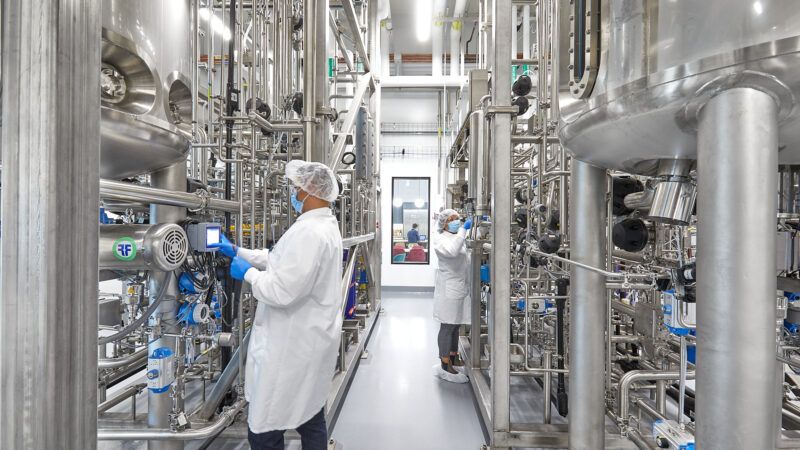Come Next Thanksgiving, We Might Be Giving Thanks for Government-Approved, Lab-Grown Turkey
Regulators are beginning to smile on the sci-fi project of creating real meat products without the typical death and environmental destruction.

People concerned about the ethics of eating meat, but still eager to participate in the typical Thanksgiving feast, might not have to choke down tofurkey for too much longer.
That's thanks to the efforts of nascent "cultivated meat" companies plugging away at the seemingly impossible task of creating real meat without the associated death and environmental damage. Seemingly more impossible still, regulators are starting to smile on the new industry's mission.
This past week, the U.S. Food and Drug Administration (FDA) (boo, hiss) completed its first-ever premarket consultation of cultivated chicken produced by Upside Foods. The agency declared that the Berkeley, California, company's process for producing lab-grown chicken from harvested live chicken cells resulted in meat that was safe for human consumption.
Pending approval from the U.S. Department of Agriculture (USDA), the company will be able being able to bring its cultivated chicken to market.
"We're in early days but the FDA greenlight is the opening of the floodgates," says Eric Schulze, Upside's vice president of regulatory and public policy. "Any meat that is commonly consumed as food, we are working on."
Schulze tells Reason that Upside can produce anywhere from 5,000 to 400,000 pounds of cultivated meat at its Engineering, Production, and Innovation Center (EPIC) production facility in the Bay Area city of Emeryville, California.
It's at the EPIC facility that the company takes small cell samples of live animal muscle, fat, and sinew tissue and sticks them in large, stainless-steel tanks where they're "fed" with water, sugar, amino acids, and other basic nutrients.
"They're grown in what looks very similar to I'd say a beer brewery or dairy operation-looking facility," says Schulze. "The goal of the entire process is to take that one cell that we've identified and grow trillions of cells."
Upside Foods' plan is to soon migrate to a commercial facility capable of producing up to 15 million pounds of cultivated meat, poultry, and seafood for sale in restaurants and grocery stores.
The budding cultivated meat industry's pitch is that it can produce a product with the same taste and nutritional value as normal meat, but without necessarily having to kill any animals. Growing meat in labs will also theoretically cut down on land needed for farms, and all the emissions and natural habitat destruction that come with them.
There are currently 42 cultivated meat companies operating in the U.S., although Upside remains the only one with any sort of government sign-off. Singapore has approved two products from one cultivated meat company. There are 151 cultivated meat companies globally, according to the Good Food Institute (GFI).
Madeline Cohen, a regulatory attorney with GFI, says that the FDA and USDA have been pretty transparent in terms of regulatory requirements that cultivated food companies have to meet in order to bring their products to market.
In 2019, the two agencies inked a joint agreement for how they'd regulate cultivated meat products.
The FDA is responsible for giving premarket verification that the processes used by cultivated meat companies create meat safe for human consumption. This is something it already does for pharmaceutical products, but generally not for foodstuffs.
The USDA is then responsible for inspecting the actual facilities and regulating the labeling of cultivated meat, poultry, and catfish products (cultivated seafood remains the exclusive domain of the FDA).
Labeling is what presents the largest regulatory risk to the industry, says Cohen.
A number of states have already passed laws restricting what plant-based and cultivated meat companies can call their products, often with the explicit intent of protecting traditional meat producers.
"Some of those laws carry stiff penalties that can be pretty financially ruinous for a company if they're facing a penalty per product per day," says Cohen. Complying with these laws isn't always easy either.
Large-scale food distributors are often regional, meaning that food producers don't necessarily know in which states their products will end up being sold.
"If you need to keep a certain product out of Missouri or you need a certain label on a cultivated meat label, you'll probably need to use the same label in the entire region so that one of your products never ends up in Missouri," Cohen says.
Such labeling laws in Louisiana and California have been successfully challenged on First Amendment grounds.
How they'll end up being labeled at the federal level remains to be seen. The FDA and USDA are still in the process of crafting standards for cultivated meat products. The USDA has said that it will approve labels on a product-by-product basis until it finalizes more formal regulations.
That doesn't give companies a lot of certainty when trying to bring products to market.
At the moment, a lot of these regulatory headaches are mostly theoretical. As mentioned, Upside is the only company to be nearing the ability to put its products in front of consumers.
Schulze says that Upside's chicken will first be served in restaurants, before hopefully making its way to grocery stores.
On when people might be feasting on cultivated turkey for Thanksgiving, he declined to make any predictions.
"I think 2023 is going to be an interesting year," says Schulze. "we'll have the first cultivate meat product on the market competing against traditional meat."
So maybe by next Thanksgiving, a trendy restaurant somewhere can serve up turkey leg while leaving the turkey it came from still standing.
Rent Free is a weekly newsletter from Christian Britschgi on urbanism and the fight for less regulation, more housing, more property rights, and more freedom in America's cities.


Show Comments (83)